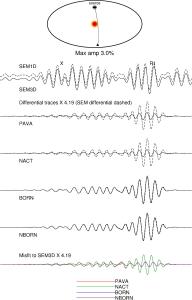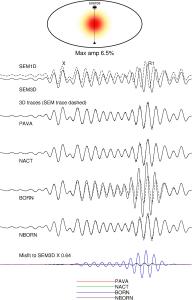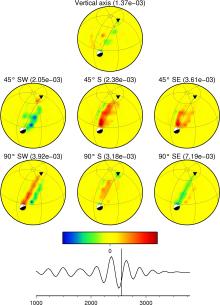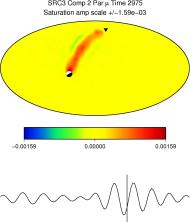Theoretical interests
I am interested in understanding and developing long period seismological theoretical approaches necessary to make a new generation of global anisotropic models. This includes examining the performance of 3D surface waveform sensitivity kernels and suggesting methods to improve them. Work is also underway to develop surface waveform sensitivity kernels for geodynamically relevant parameterizations of anisotropy, which are well-suited for combination with SKS splitting intensity measurements for potentially powerful new models of anisotropic structure.
Problems with first order 3D Born surface waveform kernels and some possible modifications
Reference
M.P. Panning, Y. Capdeville, and B.A. Romanowicz, "Seismic waveform modelling in a 3-D Earth using the Born approximation: potential shortcomings and a remedy," Geophys. J. Int., 177, 161-178, doi:10.1111/j.1365-246X.2008.04050.x, 2009. (Click for preprint)
Summary
Differential seismograms comparing several mode theoretical approximations (solid lines) to numerical results from a spectral element code (dashed lines) for a path grazing an anomaly comparable to the width of the Fresnel zone. Click to enlarge
Many recent tomographic studies attempt to improve resolution by modeling 3D sensitivity of seismic observables based on the first order Born approximation, but there has been little effort to systematically determine how well such methods forward model realistic seismic data in comparison with other methods. Comparing 3D Born kernels and great-circle based approximations with numerical results for simple model shows that 3D Born waveform kernels more accurately model perturbations by anomalies that are comparable in wavelength or smaller than the first Fresnel zone. However, larger wavelength and amplitude anomalies can easily produce large phase delays that cause the first order (linear) Born approximation to break down, while great-circle based methods can fit the data by perturbing the phase rather than the amplitude of the waveform.
Full seismograms comparing the mode theoretical approximations (solid lines) to numerical results from a spectral element code (dashed lines) for a path through an anomaly much larger than the Fresnel zone. Click to enlarge
A modification to the Born-modeled waveforms by adding in higher order terms based on the path-average predicted phase delay significantly improves the modeling of waveforms perturbed by large phase delays from long-wavelength structure, while still modeling the 3D sensitivity effects important to correctly model the effect of shorter-wavelength structure. This modification is shown by the seismograms labeled NBORN in the figures to the right, which has a fit comparable to the 3D first order Born kernels where it performs well for the smaller anomaly, but performs as well as the path-average approximation (PAVA) and non-linear asymptotic coupling theory (NACT) for the long wavelength anomaly that causes a breakdown in the first order Born approximated waveforms.
Tests in random models with structural wavelengths consistent with existing global seismic models indicate that the linear Born approximation frequently breaks down in realistic seismic settings, with worse misfit for first and second orbit Rayleigh and higher mode surface waveforms than the great-circle based approximations at all distances tested greater than 20 degrees. For fundamental modes, the average misfit for linear Born kernels is quite poor, particularly for distances larger than 60 degrees. The modified Born theory consistently improves the fit relative to the linear Born waveforms, but only outperforms the great-circle based approximations for the higher mode surface waveforms. Commonly utilized phase delay kernels for multi-taper measurements of fundamental mode Rayleigh waves developed from the Born approximation appear to be less problematic than the linear waveform kernels with general agreement with measurements, but still do not appear to match synthetic observations within measurement error.
Surface wave tomography for geodynamically relevant anisotropic models
References
M.P. Panning and G. Nolet, "Surface wave tomography for azimuthal aisotropy in a strongly reduced parameter space," Geophys. J. Int., 174, 629-648, doi:10.1111/j.1365-246X.2008.03833.x, 2008. (preprint)
M.P. Panning and G. Nolet, "Surface wave tomography for geodynamically relevant anisotropic models," Eos Trans. AGU, 88, Fall Meet. Suppl., Abstract S23B-1372, 2007. (poster)
Summary
Example kernels for a Love wave with a minimum period of 250 seconds at the time indicated in the bottom trace. The top is for a vertical symmetry axis, while the other panels show an axis tilting 45 degrees (middle) and horizontal (bottom), tipping to the SW (left), S (center), and SE (right). Click to enlarge.
Using seismic data to constrain not only the strength of anisotropy, but the orientation of the best-fitting symmetry axis is important for geodynamic understanding, as this can be related to mantle convection flow patterns. Surface wave models, though, often only deal with anisotropy with a vertical axis of symmetry (e.g. my previous work). Conversely, SKS splitting measurements have typically been modeled assuming a horizontal axis of symmetry for the material properties. Recently, however, methods have been developed for using splitting measurements in tomographic inversions for more general symmetry axis orientations. There have also been surface wave studies which model azimuthal dependence of Rayleigh wave velocity through linearized dependence on a horizontal fast axis. As the frequency content of body wave splitting measurements and surface wave observations differ greatly, it is essential to have an appropriate finite frequency theory in order to include both in a consistent framework.
Still frame from a movie of the time dependence of a waveform kernel for perturbations to the isotropic elastic coefficient mu. Click to see movie.
We derive nonlinear expressions for 3D finite-frequency surface wave sensitivity to arbitrarily oriented hexagonal symmetric media. The nonlinear dependence on the symmetry axis is apparent in the changes to the kernel in the first figure to the right. Since these are waveform kernels, they also vary as a function of time. The second figure shows a still from a movie of a sensitivity kernel for perturbations to the isotropic elastic coefficient mu for the horizontal component of a Rayleigh wave as a function of time.



